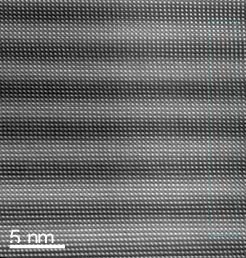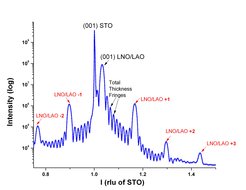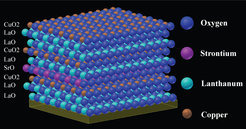LAYER-BY-LAYER DEPOSITION OF METAL OXIDES
Artificial stacking of different epitaxial complex oxides film is the new route to new physical phenomena, new functional interfaces and new materials. The pulsed-laser-deposition (PLD) method have used and further developed for this purpose relies on the laser-induced ablation of stoichiometric metal-oxide targets and allows accurate control of the layer thickness and sequence, in recent years down to monolayer precision. The thin films and multilayers prepared in this way have led to many advances and insights, especially regarding the interplay between magnetism and superconductivity [1-6] and search for superconductivity induced by orbital reconstruction at the interface between LaNiO3 and LaAlO3 [7,8]. Typical high resolution Transmission Electron Microscopy (TEM) image and X-Ray Diffraction (XRD) pattern are shown in Fig. 1 and 2 correspondingly.


Fig. 2: High resolution XRD patern from (4uc/4uc)10 LaNiO3-LaAlO3 superlatice (b).
Recently the new dual oxide MBE system has been installed in Max-Planck Institute, Scientific Service group Technology (see laboratory tour). This system is well suited, by design, for depositing alternative layers with the precision better than a single atomic layer. The lower kinetic energy of the impinging particles and highly accurate control of the deposition process allow the synthesis of heterostructures and superlattices with chemical and structural integrity down to sub-unit-cell dimensions.
The combination of PLD and MBE methods will allow highly efficient exploration and accurate fabrication of new heterostructure systems with defect control at the atomic level. This allows us to push further the layer-by-layer deposition process [1-3] to prove the principles of the atomic layer engineering (ALE) of new metastable layered oxide compounds with in-situ RHEED control. By using oxide MBE we study the formation of new metastable layered compounds with different sequence of single atomic layers, we can grow metastable compounds which do not exist in the nature and investigate the influence of the dopants layers on physical properties of different complex oxides, including high temperature superconductivity, magnetism charge and spin ordering etc. In Figure 3 the illustration of Sr-delta doping in a La2CuO4 compound with full substitution of one LaO layer by a complete SrO layer grown by using ALE technique is shown.

Fig.3: Schematic illustration of strontium δ-doping in La2CuO4 using atomic layer-by-layer molecular beam epitaxy.
References
[1] Proximity induced metal-insulator transition in YBa2Cu3O7/La2/3Ca1/3MnO3 superlattices. Holden, T. et al. Phys. Rev.B 69, 064505 (2004).
[2] Magnetic proximity effect in perovskite superconductor/ferromagnet multilayers. Stahn, J. et al. Phys. Rev B 71, 140509 (R) (2005).
[3] Magnetism at the interface between ferromagnetic and superconducting oxides. Chakhalian, J. et al. Nature Phys. 2, 244 (2006).
[4] Orbital Reconstruction and Covalent Bonding at an Oxide Interface. Chakhalian, J. et al. Science 318, 1114 (2007).
[5] On magnetic interlayer coupling and proximity effect in a La0.67Ca0.33MnO3 (10 nm)/YBa2Cu3O7 (10 nm) superlattice. Freeland, J.W. et al. Appl. Phys. Lett. 90,242502 (2007).
[7] Spin, Orbital, and Charge Order at the Interface between Correlated Oxides. Jackeli, G. Khaliulin, G. Phys. Rev. Lett. 101, 216804 (2008).
[8] Dimensionality Control of Electronic Phase Transitions in Nickel-Oxide Superlattices. Boris, A. et al. Science 332, 937 (2011).
[9] Atomic-layer engineering of superconducting oxides: yesterday, today, tomorrow. Bozovic, I IEEE Trans. Appl. Supercon. 11, 2686 (2001).
[10] Epitaxial strain and superconductivity in La2-xSrxCuO4 thin films. Bozovic, I. et al. Phys. Rev. Lett. 89, 107001(2002).
[11] High-Temperature Superconductivity in a Single Copper-Oxygen Plane. Logvenov,G. Gozar,A. Bozovic,I. Science 326, 699 (2009).


